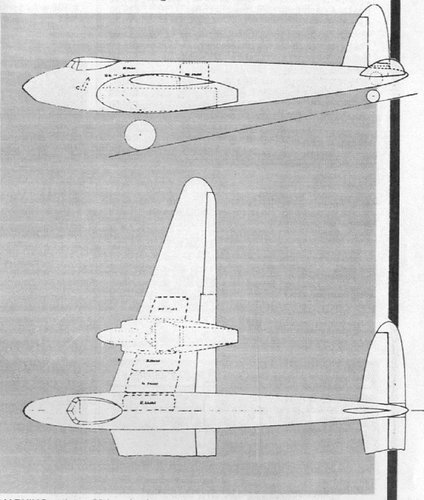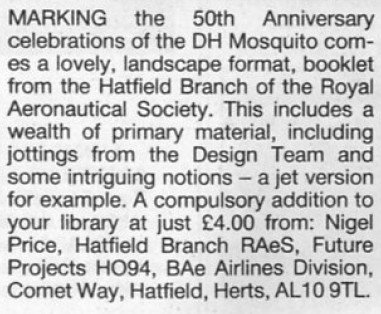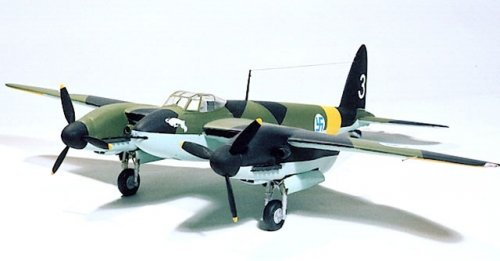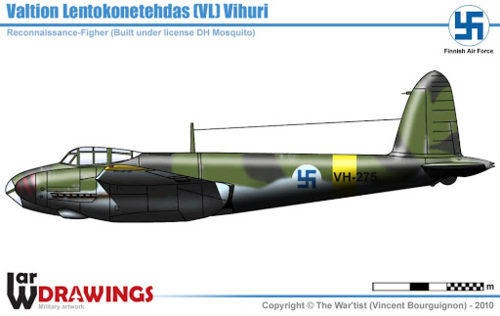You are using an out of date browser. It may not display this or other websites correctly.
You should upgrade or use an alternative browser.
You should upgrade or use an alternative browser.
de Havilland Mosquito - Unbuilt Versions and Variants
- Thread starter Antonio
- Start date
Nice find.
- Joined
- 22 April 2012
- Messages
- 2,270
- Reaction score
- 2,045
That's just a mock-up of the Bristol B.11 Mk.1A (the Mk.1 was planned for the Beaumont light bomber) turret with 4 x .303 inch guns. The Boulton Paul proposal is interesting as twin .50 cals in a remotely controlled barbette suggests it is a relatively late-war proposal.
- Joined
- 11 March 2012
- Messages
- 3,122
- Reaction score
- 2,962
They briefly flew a Mosquito with a mock-up turret. The turret considerably slowed the Mosquito and created turbulent airflow over the rudder. Even stock Mossie's had poor rudder control at landing speeds.
- Joined
- 11 March 2012
- Messages
- 3,122
- Reaction score
- 2,962
That photo of a turret mock-up looks like the photo in the old "Profile" series of booklets.
The same page had a photo of speed brakes. They completely encircled the fuselage - just aft of the wing - and opened like an umbrella. Speed brakes were intended to prevent Mosquito night-fighters from over-taking their prey.
Another series (Secret Fighters/Projects of the RAF?) contains both a description and a small model of a Mosquito successor powered by Rolls Royce Griffon engines. The model has a completely different wing, with straight trailing edge and slightly swept leading edges.
The same page had a photo of speed brakes. They completely encircled the fuselage - just aft of the wing - and opened like an umbrella. Speed brakes were intended to prevent Mosquito night-fighters from over-taking their prey.
Another series (Secret Fighters/Projects of the RAF?) contains both a description and a small model of a Mosquito successor powered by Rolls Royce Griffon engines. The model has a completely different wing, with straight trailing edge and slightly swept leading edges.
von hitchofen
This space has been intentionally left blank.
- Joined
- 26 November 2014
- Messages
- 40
- Reaction score
- 46
102
patvig
ACCESS: Confidential
Jet Mosquito
It wa a 1942 project : http://www.militaryfactory.com/aircraft/detail.asp?aircraft_id=1716
It wa a 1942 project : http://www.militaryfactory.com/aircraft/detail.asp?aircraft_id=1716
- Joined
- 9 October 2009
- Messages
- 21,147
- Reaction score
- 12,249
On an interesting tangent: http://www.telegraph.co.uk/news/2017/08/06/discovery-lost-ww2-mosquito-plans-will-allow-wooden-wonder-fly/
nuuumannn
Cannae be ar*ed changing my personal text
- Joined
- 21 October 2011
- Messages
- 276
- Reaction score
- 538
On the subject of Mosquitoes armed with gun turrets, I did some fact finding on this subject and saw this image (see attached) outside The People's Mosquito stand at the Shuttleworth airshow a couple of years ago.
There were two Mossies that appeared like this, the fourth prototype W4053 and W4073. Following a decision not to employ the turret fighter Mossies, both became the prototypes of the T.III. The following is from an article I wrote for a local magazine and had published a couple of years ago:
"Flown out on the gently sloping, but barely suitable for flying operations paddock that was being used to save lengthy dismantling and reassembly time, on 14 September W4053 left for Hatfield with an actual B.11 Mk.1 turret installed. The first turret fighter’s debut could not have been more inauspicious, as a part of the cupola broke off during the short flight.
During flights to assess the turret’s operation, a rather disturbing defect was discovered. With Geoffrey de Havilland Junior flying, engineer Ted Lovatt in the right-hand seat and John de Havilland in the turret, when an attempt to rotate it to a position with the guns facing forward was made, the turret froze mid rotation, refusing to move. After two subsequent flights with the same result, personnel were prevented from flying W4053. The cause was the force from the slipstream on the moving turret overpowering its hydraulic motor, preventing it from rotating any further. This was a considerable fly in the turret fighter’s ointment, as in flight, the gunner would need to rotate the turret forward to get out in an emergency. In the Mosquito, access to the turret was from the exterior only, there being no internal ingress.
On 5 December, W4073, the second turret fighter flew for the first time, but was shortly delivered to Boscombe Down, Wiltshire, where the Bristol turret and modifications to accommodate it were removed. This is because following the findings of W4050’s aerodynamic trials in late July, the Air Ministry had rejected the turret armed Mosquito."
The prototype W4050 is pictured above in post #3 with the mock-up turret and the last time I was at the De Havilland Aviation Heritage Museum I asked the guys restoring it about the turret mods. Because it was an unmoving mock-up, there were locating lugs that still survived beneath the skin. They've been retained, but they did point out a faint rubbing mark on the canopy that is a remnant from the turret trials (see attached).
From my article:
"In the interim, W4050 was fitted with a fixed aerodynamic mock-up of the turret installation in July 1941, and flown by R.M. Clarkson, made its first flight with it on the 24th of that month. A commonly reproduced image shows a close up of W4050’s canopy from the left side, with the mock-up turret visible with its ‘guns’ at their maximum elevation facing forward. Dummy gun location holes in the turret side are clearly visible, as is the tunnel fairing encapsulating the after section of the cockpit canopy.
W4050’s wing structure was not altered to accommodate the turret, as it was intended in the production turret fighter. At the time, the prototype was undergoing numerous aerodynamic trials, including the effects of stalling, as it was fitted with leading edge slots, which were eventually closed and not fitted to any other example, flying with the bomb doors open and localised airflow around critical areas. As the turret was not operational, the dummy guns were removed and placed in the holes located in the turret body to simulate their aerodynamic impact facing in different directions, with the bomb bay doors open and closed.
Handling during these experiments was found to be satisfactory overall, which was a good omen for the projected turret fighter, but 20mph was lost from the prototype’s exceptional performance without the turret and a higher landing speed was recorded. During trials, the four dummy guns were faced fore, aft and to the left and right, and speed measurements taken with each direction they faced. Aligned aft, a true airspeed of 352mph at an altitude of 14,050ft was recorded. To the side, 334mph at 14,050ft was reached and 337mph at 14,000ft with the guns aligned forward was attained. Handling was also assessed with the guns raised to their maximum elevation, no adverse effects were noted. These figures illustrate the degree of variation in speed – and the penalty the turret’s operation imposed on the aircraft’s performance."
There were two Mossies that appeared like this, the fourth prototype W4053 and W4073. Following a decision not to employ the turret fighter Mossies, both became the prototypes of the T.III. The following is from an article I wrote for a local magazine and had published a couple of years ago:
"Flown out on the gently sloping, but barely suitable for flying operations paddock that was being used to save lengthy dismantling and reassembly time, on 14 September W4053 left for Hatfield with an actual B.11 Mk.1 turret installed. The first turret fighter’s debut could not have been more inauspicious, as a part of the cupola broke off during the short flight.
During flights to assess the turret’s operation, a rather disturbing defect was discovered. With Geoffrey de Havilland Junior flying, engineer Ted Lovatt in the right-hand seat and John de Havilland in the turret, when an attempt to rotate it to a position with the guns facing forward was made, the turret froze mid rotation, refusing to move. After two subsequent flights with the same result, personnel were prevented from flying W4053. The cause was the force from the slipstream on the moving turret overpowering its hydraulic motor, preventing it from rotating any further. This was a considerable fly in the turret fighter’s ointment, as in flight, the gunner would need to rotate the turret forward to get out in an emergency. In the Mosquito, access to the turret was from the exterior only, there being no internal ingress.
On 5 December, W4073, the second turret fighter flew for the first time, but was shortly delivered to Boscombe Down, Wiltshire, where the Bristol turret and modifications to accommodate it were removed. This is because following the findings of W4050’s aerodynamic trials in late July, the Air Ministry had rejected the turret armed Mosquito."
The prototype W4050 is pictured above in post #3 with the mock-up turret and the last time I was at the De Havilland Aviation Heritage Museum I asked the guys restoring it about the turret mods. Because it was an unmoving mock-up, there were locating lugs that still survived beneath the skin. They've been retained, but they did point out a faint rubbing mark on the canopy that is a remnant from the turret trials (see attached).
From my article:
"In the interim, W4050 was fitted with a fixed aerodynamic mock-up of the turret installation in July 1941, and flown by R.M. Clarkson, made its first flight with it on the 24th of that month. A commonly reproduced image shows a close up of W4050’s canopy from the left side, with the mock-up turret visible with its ‘guns’ at their maximum elevation facing forward. Dummy gun location holes in the turret side are clearly visible, as is the tunnel fairing encapsulating the after section of the cockpit canopy.
W4050’s wing structure was not altered to accommodate the turret, as it was intended in the production turret fighter. At the time, the prototype was undergoing numerous aerodynamic trials, including the effects of stalling, as it was fitted with leading edge slots, which were eventually closed and not fitted to any other example, flying with the bomb doors open and localised airflow around critical areas. As the turret was not operational, the dummy guns were removed and placed in the holes located in the turret body to simulate their aerodynamic impact facing in different directions, with the bomb bay doors open and closed.
Handling during these experiments was found to be satisfactory overall, which was a good omen for the projected turret fighter, but 20mph was lost from the prototype’s exceptional performance without the turret and a higher landing speed was recorded. During trials, the four dummy guns were faced fore, aft and to the left and right, and speed measurements taken with each direction they faced. Aligned aft, a true airspeed of 352mph at an altitude of 14,050ft was recorded. To the side, 334mph at 14,050ft was reached and 337mph at 14,000ft with the guns aligned forward was attained. Handling was also assessed with the guns raised to their maximum elevation, no adverse effects were noted. These figures illustrate the degree of variation in speed – and the penalty the turret’s operation imposed on the aircraft’s performance."
Attachments
nuuumannn
Cannae be ar*ed changing my personal text
- Joined
- 21 October 2011
- Messages
- 276
- Reaction score
- 538
On the subject of Mossies, I thought y'all might be interested in these pics I took a good few years ago. They aren't the best as I had a crappy little digital hand held at the event.
Attachments
V.L. Vihuri
In 1943 the Finns were waiting to receive two crashed British de Havilland Mosquito, requested from Germany to serve as models for planned production. One would be repaired and another one would be teared into parts to make blueprints. The Finns are great wood workers and probably would have been able to circumvent the unavailability of balsa and Tego-film, with the technique used by the Soviets in the construction of the Polikarpov I-16, which already had been tested in the Pyörremyrsky. The Polikarpov fuselage was built in two halves, like the Mosquito, and each half comprised pine frames and longerons. The monocoque skin was produced from layers of birch strips glued cross-grained and molded on a former.
The new aircraft, called Vihuri, would have possibly been used as fighter-bomber with nose-mounted machine guns. It would have been powered by two 1,475 hp German Daimler-Benz DB 605 AC engines and used the landing gear of the Bristol Blenheim. It was estimated that its performances would have been inferior to those of the Mosquito because of its greater structural weight. Production plans would have delivered between mid of 1946 and December 1947, due to the overload of work that represented for V.L. the repair of fighters in service, the production of the Myrsky and the Mörkö-Moraani conversion.
Attachments
Temistocle
ACCESS: Secret
- Joined
- 9 December 2009
- Messages
- 219
- Reaction score
- 445
Some actual drawings have been discovered of the Jet Mosquito only a few years ago, along with drawings of the DH.101 and DH.102. They have been left in the care of Tony Butler. I've got a copy of the DH.101 drawings which Tony gave to me while I was figuring out the actually size of it. An announcement of the discovery was made in the Spring 2005 issue of Air-Britain's AeroMilitaria.
Last edited:
- Joined
- 25 July 2007
- Messages
- 4,167
- Reaction score
- 3,835
It is (built for Tony Buttler's BSP book). The photo was taken at the IPMS UK Scale Modelworld 2005 show at Telford. The source:
The yellow one was built by 'Balsabasher':
 smm.solidmodelmemories.net
smm.solidmodelmemories.net
The yellow one was built by 'Balsabasher':
Balsabasher Collection - Jet Mosquito by Balsabasher - Solid Model Memories
- Joined
- 19 July 2016
- Messages
- 4,001
- Reaction score
- 3,050
Thanks for those, much appreciated.
Airborne2001
ACCESS: Confidential
- Joined
- 19 June 2020
- Messages
- 166
- Reaction score
- 169
November 2022 Aeroplane magazine has a nice piece by Grant Newman on Mosquito turret fighters including a snippet showing a manned tail turret position 
- Joined
- 19 October 2012
- Messages
- 1,953
- Reaction score
- 1,842
The tail turret appears briefly in this film made by DH after the war (from 5.25 minutes onwards)
View: https://www.youtube.com/watch?v=vh4vazBq-X4
The resolution is poor but with a few screen captures, perspective correction and compensation for the creases and wrinkles (crude but OK) it is possible to produce a reasonable view of the design. Everything to the right of the red dotted line is seen on the film, the dotted part to the left is guesswork based on the Mosquito as built. However I am sure this is not correct as the props are in line with the cockpit and it does not appear that the CG would fall in the appropriate place given the weight of the turret in the tail.

The resolution is poor but with a few screen captures, perspective correction and compensation for the creases and wrinkles (crude but OK) it is possible to produce a reasonable view of the design. Everything to the right of the red dotted line is seen on the film, the dotted part to the left is guesswork based on the Mosquito as built. However I am sure this is not correct as the props are in line with the cockpit and it does not appear that the CG would fall in the appropriate place given the weight of the turret in the tail.
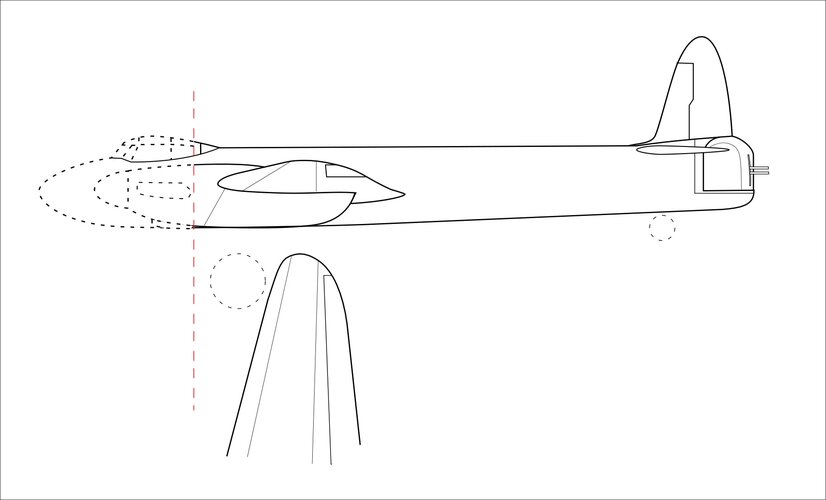
Last edited:
The tail turret appears briefly in this film made by DH after the war (from 5.25 minutes onwards)
View: https://www.youtube.com/watch?v=vh4vazBq-X4
The resolution is poor but with a few screen captures, perspective correction and compensation for the creases and wrinkles (crude but OK) it is possible to produce a reasonable view of the design. Everything to the right of the red dotted line is seen on the film, the dotted part to the left is guesswork based on the Mosquito as built. However I am sure this is not correct as the props are in line with the cockpit and it does not appear that the CG would fall in the appropriate place given the weight of the turret in the tail.
View attachment 686007

- Joined
- 6 September 2006
- Messages
- 4,620
- Reaction score
- 8,609
The film is grainy but it's possible the cockpit is a little further aft.
It feels like a McGuffin to me, something doodled up to show how fitting any tail armament is a bad idea in order to sell the Mosquito concept to the Air Marshals and civil servants.
It feels like a McGuffin to me, something doodled up to show how fitting any tail armament is a bad idea in order to sell the Mosquito concept to the Air Marshals and civil servants.
- Joined
- 19 October 2012
- Messages
- 1,953
- Reaction score
- 1,842
I did wonder about that too, but it is known that the lack of defensive armament was an issue or some in the AM and RAF and DH did investigate options. Whether a heavy manned turret was even feasible does appear questionable. The other point that could suggest that some thought was given to the design is the wingplan with leading edge sweep which would bring the centre of lift rearwards, albeit not by much. Still, I agree that the jury is out on whether this was mocked up for the film or was a genuine early concept.The film is grainy but it's possible the cockpit is a little further aft.
It feels like a McGuffin to me, something doodled up to show how fitting any tail armament is a bad idea in order to sell the Mosquito concept to the Air Marshals and civil servants.
I did wonder about that too, but it is known that the lack of defensive armament was an issue or some in the AM and RAF and DH did investigate options. Whether a heavy manned turret was even feasible does appear questionable. The other point that could suggest that some thought was given to the design is the wingplan with leading edge sweep which would bring the centre of lift rearwards, albeit not by much. Still, I agree that the jury is out on whether this was mocked up for the film or was a genuine early concept.The film is grainy but it's possible the cockpit is a little further aft.
It feels like a McGuffin to me, something doodled up to show how fitting any tail armament is a bad idea in order to sell the Mosquito concept to the Air Marshals and civil servants.
The fuselage in the drawing looks a bit like that of the AW B.7/40 but with the single rudder?
Didn't the R J Mitchel design to B.1/35 have a heavy turret aft?
Last edited:
- Joined
- 19 October 2012
- Messages
- 1,953
- Reaction score
- 1,842
Not exactly, it had a single gun in a sort of mobile 'stinger' housing while the gunner sat in a fixed enclosure at the base of the finI did wonder about that too, but it is known that the lack of defensive armament was an issue or some in the AM and RAF and DH did investigate options. Whether a heavy manned turret was even feasible does appear questionable. The other point that could suggest that some thought was given to the design is the wingplan with leading edge sweep which would bring the centre of lift rearwards, albeit not by much. Still, I agree that the jury is out on whether this was mocked up for the film or was a genuine early concept.The film is grainy but it's possible the cockpit is a little further aft.
It feels like a McGuffin to me, something doodled up to show how fitting any tail armament is a bad idea in order to sell the Mosquito concept to the Air Marshals and civil servants.
The fuselage in the drawing looks a bit like that of the AW B.7/40 but with the single rudder?
Didn't the R J Mitchel design to B.1/35 have a heavy turret aft?
This is the edition you are after - the article is a good read:November 2022 Aeroplane magazine has a nice piece by Grant Newman on Mosquito turret fighters including a snippet showing a manned tail turret position

There's also an interesting article on the TSR2, P1154 and HS681 by some guy called Chris Gibson...

Not exactly, it had a single gun in a sort of mobile 'stinger' housing while the gunner sat in a fixed enclosure at the base of the finI did wonder about that too, but it is known that the lack of defensive armament was an issue or some in the AM and RAF and DH did investigate options. Whether a heavy manned turret was even feasible does appear questionable. The other point that could suggest that some thought was given to the design is the wingplan with leading edge sweep which would bring the centre of lift rearwards, albeit not by much. Still, I agree that the jury is out on whether this was mocked up for the film or was a genuine early concept.The film is grainy but it's possible the cockpit is a little further aft.
It feels like a McGuffin to me, something doodled up to show how fitting any tail armament is a bad idea in order to sell the Mosquito concept to the Air Marshals and civil servants.
The fuselage in the drawing looks a bit like that of the AW B.7/40 but with the single rudder?
Didn't the R J Mitchel design to B.1/35 have a heavy turret aft?
Oh yes, was it absolutley necessary for the gunner to be there, would it have been possible at the time to have the gunner's position further forward as in say the US North American XB.28?
Cudos on reconstructing the sketch from the frames in the film.The tail turret appears briefly in this film made by DH after the war (from 5.25 minutes onwards)
The resolution is poor but with a few screen captures, perspective correction and compensation for the creases and wrinkles (crude but OK) it is possible to produce a reasonable view of the design. Everything to the right of the red dotted line is seen on the film, the dotted part to the left is guesswork based on the Mosquito as built. However I am sure this is not correct as the props are in line with the cockpit and it does not appear that the CG would fall in the appropriate place given the weight of the turret in the tail.
View attachment 686007
But I would be surprised if the original drawing were not a bit of artistic license specially produced for the film, as a way of visually illustrating a point that would take too long to make as effectively using narration.
I have a hard time believing that an aeronautical engineer would have drawn something this, even as a rough, conceptual sketch. Even if we could explain the center-of-gravity issue that others note, the fin and rudder are too small and the abrupt change of section before the turret seem unworkmanlike and likely to cause aerodynamic problems with the tail surfaces. Finally, we know that the well-attested armament studies for the Mosquito all placed a compact turret in the aft portion of the canopy, thus avoiding these obvious problems.
- Joined
- 19 October 2012
- Messages
- 1,953
- Reaction score
- 1,842
The other issue is that I doubt that it would have been possible to access the turret given restrictions imposed by position of the well for the retractable tailwheel and the attachment for the tailplane. One of the reasons for producing the drawing from the film was to assess how plausible it could have been, and I share your reservations.
- Joined
- 6 September 2006
- Messages
- 4,620
- Reaction score
- 8,609
Having now read the article it looks like the tail-turreted Mosquito was to be the larger Griffon-powered airframe. Versions with two and four-gun tail turrets were studied. Tedder and Sholto-Douglas both favoured ordering two prototypes but DH and Freeman successfully got this rescinded to concentrate on the unarmed Merlin version.
Could this snippet from the film be the long-lost Griffon DH.98 with a tail turret? The turret was to be a Nash and Thompson FN4A and the shape of the turret does seem identical. The larger airframe would also go some way to alleviate the C.G. issue, though I can't find any dimensional data for C. C. Walker's larger Griffon DH.98 of November 1939 to ascertain exactly how much it was scaled up by.
Could this snippet from the film be the long-lost Griffon DH.98 with a tail turret? The turret was to be a Nash and Thompson FN4A and the shape of the turret does seem identical. The larger airframe would also go some way to alleviate the C.G. issue, though I can't find any dimensional data for C. C. Walker's larger Griffon DH.98 of November 1939 to ascertain exactly how much it was scaled up by.
- Joined
- 19 October 2012
- Messages
- 1,953
- Reaction score
- 1,842
We need an expert in turret mechanisms to answer that. Supermarine, possibly in conjunction with Barnes Wallis at Vickers, did investigate a few systems where the gunner was somewhat remote from the guns, for example that which was proposed for the Type 305 turret fighter
Oh yes, was it absolutley necessary for the gunner to be there, would it have been possible at the time to have the gunner's position further forward as in say the US North American XB.28?
The Griffon powered 'DH.98 Mosquito', was the DH.102. It was bigger than the DH.98 and according to what's written, was a "scaled down" DH.101. There wouldn't have been very much in common though, between the DH.98 and DH.101/102.Having now read the article it looks like the tail-turreted Mosquito was to be the larger Griffon-powered airframe. Versions with two and four-gun tail turrets were studied. Tedder and Sholto-Douglas both favoured ordering two prototypes but DH and Freeman successfully got this rescinded to concentrate on the unarmed Merlin version.
Could this snippet from the film be the long-lost Griffon DH.98 with a tail turret? The turret was to be a Nash and Thompson FN4A and the shape of the turret does seem identical. The larger airframe would also go some way to alleviate the C.G. issue, though I can't find any dimensional data for C. C. Walker's larger Griffon DH.98 of November 1939 to ascertain exactly how much it was scaled up by.
I've been trying to make a model of both of these using a copy of the DH.101 drawings which Tony Buttler kindly supplied to me after I had asked him a number of questions about the DH.101 when it first appeared in a brief article in Air-Britain's AeroMilitaria some years ago. I worked out that the DH.101 was scaled up 1.2 bigger than the DH.98 and then the DH.102 was scaled down again so it was about 1.1 bigger than the DH.98.
Here you can see the difference between the DH.98 and the DH.101
Attachments
Last edited:
There is an article in a recent Air-Britain Aviation World about this project. Towards the end of the war, VL proposed to reverse engineer a Mosquito but use DB-605 engines. Their plan was to buy two flyable Mosquito's captured by the Germans using one to reverse engineer, and the other for comparison tests once the 'copy' had been built.Valmet Vihuri (Not the same as the trainer.)
View attachment 637887
Mosquito with DB-605 engines.
View attachment 637888
View attachment 637889
Not exactly sure about how it was supposed to look, so if someone could fix the discrepancy in looks between the first and third pictures in regards to the second it would be much appreciated.
Similar threads
-
-
de Havilland project between the DH 102 Mosquito II and the DH 103 Hornet?
- Started by BarnOwlLover2
- Replies: 8
-
-
-
What if De Havilland Mosquito had hydro version..
- Started by airman
- Replies: 1












